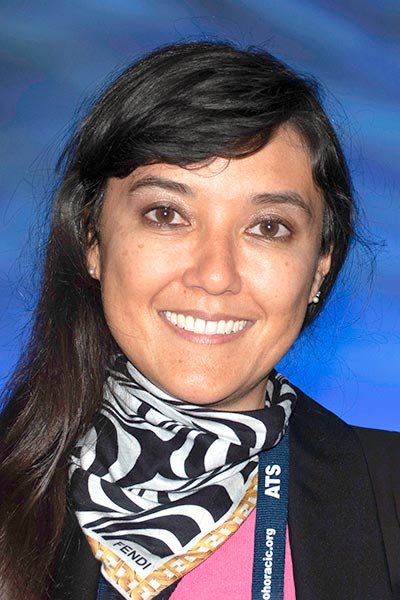With more than 200 heterogeneous, overlapping subtypes that affect the lung parenchyma with variant patterns of inflammation and fibrosis, interstitial lung disease is one of the most difficult lung diseases to diagnose.

“ILD can affect the interstitial space, alveoli, and airway architecture,” said Erica Farrand, MD, assistant professor of pulmonary, critical care, allergy, and sleep medicine, University of California, San Francisco. “Making a specific diagnosis at the outset is as important now as it ever was despite our expanding collection of antifibrotic agents.”
Dr. Farrand opened the first of two Pulmonary Clinical Core Curriculum sessions, which were held on Monday and Tuesday, May 16 and May 17, during ATS 2022.
Diffuse ILD falls into five primary subtypes: connective tissue disease-related, exposure-related, idiopathic interstitial pneumonias, granulomatous, and other. Some ILD variants are rare, some are major, some cannot be classified, Dr. Farrand said, and all have their own natural history, treatment, and prognosis.
Idiopathic pulmonary fibrosis is the most common subtype of ILD and can often be diagnosed by high-resolution computed tomography, clinical presentation, medical history, and physical exam. Pulmonary function tests can help in baseline diagnosis, Dr. Farrand said, but results are not specific for IPF. Serial testing can help estimate prognosis, progression, and response to therapy.
HRCT is key to establishing an ILD diagnosis and may become more specific as the disease progresses. Lung biopsy can be helpful if the diagnosis is uncertain, Dr. Farrand noted, but should be avoided if the patient has acute respiratory failure or if diffusing capacity of the lung for carbon monoxide is less than 35 percent.
Between 10 percent and 20 percent of patients cannot be classified even with a multidisciplinary conference, Dr. Farrand said, adding that empiric antifibrotic or immunomodulatory therapy could be considered based on patient and disease features.

Granulomatous lung diseases can be similarly complex. Granulomas form to confine pathogens, restrict inflammation, and protect surrounding tissue, said Bridget Collins, MD, clinical associate professor of pulmonary, critical care, and sleep medicine, University of Washington Medical Center. The root cause can be infectious bacterial, fungal, or parasitic, or noninfectious.
Noninfectious granulomas may be sarcoidosis, hypersensitivity pneumonitis, malignancy, drug-induced, pneumoconiosis, foreign body-related, autoimmune, or, most commonly, granulomatous lymphocytic interstitial lung disease.
“Sometimes we just see granulomas on histopathology,” Dr. Collins said. “They all have different appearance and keep different company in the lung, which can help with diagnosis.”
Sarcoidosis, for example, shows tight, well-formed, nonnecrotizing granulomas, while hypersensitivity pneumonitis forms smaller, loose, poorly formed granulomas. Aspiration-associated granulomas are well-formed, often with small foci and central necrosis. Infectious granulomas can be necrotizing or nonnecrotizing, and GL-ILD granulomas are nonnecrotizing but can be loose or well-formed.
Recent HP guidelines from CHEST and the ATS focus on diagnosis. HRCT can distinguish between fibrotic HP and nonfibrotic HP. Fibrotic HP shows a highly specific pattern of three densities: dark (air trapping), gray (normal lung), and white (ground glass opacity). Both guidelines generated diagnostic algorithms that differ in detail but lead to similar results.
“If you are looking for greater than 70 percent confidence in diagnosis, either guideline is appropriate,” Dr. Collins noted.
Many autoimmune rheumatic diseases have pulmonary manifestations, rheumatoid arthritis, systemic lupus erythematosus, scleroderma, and dermatomyositis among them. These manifestations may involve airways, parenchyma, vasculature, respiratory muscles, or pleura.

“All can lead to similar signs and symptoms,” said Leticia Kawano-Dourado, MD, PhD, research team lead, HCOR Research Institute, University of Sao Paulo, Brazil. “That is the challenge.”
Airway involvement is a good diagnostic clue for RA, she said. RA can also manifest as pulmonary fibrosis, particularly in older men who are seropositive with poorly controlled articular disease.
Idiopathic inflammatory myopathies most often manifest as ILD that is more inflammatory than fibrotic. Respiratory muscle involvement can affect lung function.
SLE is often a pleural disease. Gastroesophageal reflux disease often triggers lung inflammation and should be treated aggressively. Chest wall thickening may reduce forced vital capacity. Sjogren’s syndrome, she said, resembles RA with fibrosis and airway disease.
“HRCT is the central piece in the diagnosis,” Dr. Kawano-Dourado said. “PFT is also important. You may need histology to exclude carcinoma, but you usually do not need tissue.”
There is more expert opinion than solid evidence for managing these conditions, she continued.
“Treatment is based on disease severity and progression,” Dr. Kawano-Douorado explained. “If you see severe disease or progression, you should consider more aggressive treatment. The more inflammation, the more aggressive immune suppression, and if you see fibrosis, then antifibrotic treatment starting with mycophenolate. This is very fertile ground for research.”
Pulmonary Clinical Core Curriculum – Part 2
IPF is the most common form of ILD in North America, affecting 24–30 individuals per 100,000. It can be diagnosed by HRCT patterns of usual interstitial pneumonia. Guidelines published in May 2022 have clarified approaches to IPF as well as management options.

“IPF doesn’t always have a classic, clear-cut phenotype,” cautioned Ayodeji Adegunsoye, MD, MS, assistant professor of medicine and scientific director, Interstitial Lung Disease Program, University of Chicago. “There are variations, including combined pulmonary fibrosis and emphysema, pleuroparenchymal fibroelastosis, coexistent autoimmune features, and phenotypic clusters of IPF.”
It is nearly impossible to project progression in any of these IPF subtypes, he said, although declining lung function can help. Some patients progress slowly, some very quickly.
“IPF is progressive, irreversible, and fatal,” he said. “Whatever we do should be in concert with the patient’s wishes, preferences, and values.”
Antifibrotic treatment may help, he added, and should be started as early as possible. Patients also need help with comorbidities, including pulmonary hypertension, GERD, obstructive sleep apnea, and possibly pulmonary embolism. GERD should not be treated with antacids, and warfarin has been shown to increase mortality in IPF.
IPF is the leading indication for lung transplantation in the U.S., he said, and patients should be referred for evaluation early in the course of their disease.

The biggest change in progressive fibrotic lung disease is hope. Two antifibrotic agents — pirfenidone and nintedanib — slow decline in FVC and improve mortality by blocking downstream signaling of PDGFR (platelet-derived growth factor receptor), VEGFR (vascular endothelial growth factor receptor), and FGFR (fibroblast growth factor receptor).
“We had many failed attempts at treating pulmonary fibrosis over the years,” said Robert W. Hallowell, MD, director, Interstitial Lung Disease Program, Massachusetts General Hospital. “Now our patients have hope.”
Both pirfenidone and nintedanib come at a cost, he continued, and not just the $112,000 yearly price tag. Up to a fifth of patients discontinue treatments due to adverse events, most commonly nausea, diarrhea (especially with nintedanib), rash (pirfenidone), transaminitis, and anorexia/weight loss.
“But if there is any fibrotic subtype of lung disease, both of these antifibrotics slow FEV progression,” Dr. Hallowell said. “And there are more antifibrotics in development. Antifibrotics are becoming standard of care for patients with any element of fibrotic disease.”
REGISTER FOR ATS 2024
Register today for the ATS 2024 International Conference! Don’t miss this opportunity to take part in the in-person conference, May 17-22 in San Diego. Join your colleagues to learn about the latest developments in pulmonary, critical care, and sleep medicine.
Not an ATS member? Join today and save up to $540.
